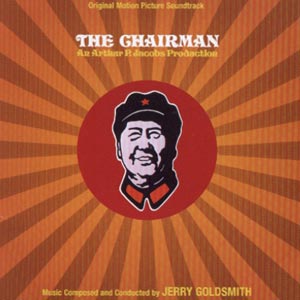The Chairman
Music composed by Jerry Goldsmith
Available on Prometheus (PCD 158)
Running Time: 31:49

The Chairman (known in the UK as The Most Dangerous Man in the World) was released by 20th Century Fox in June 1969. It starred Gregory Peck as Dr John Hathaway a biophysicist who is recruited to go to China posing as a doctor in order to steal the formula for a newly developed agricultural enzyme. [Despite its title the film deals only peripherally with Chairman Mao Tse Tsung whose presence remains mostly off-screen.].
Jerry Goldsmith was particularly busy that year scoring 100 Rifles, Justine, The Illustrated Man and The Chairman. He had written music for Planet of the Apes the year before and would soon proceed to Patton. Of course Goldsmith was no stranger to scores for films set in theFar East– The Sand Pebbles (1966) and The Spiral Road (1962).
The music for The Chairman had been issued first, by Tetragrammaton Records as an LP soundtrack recording in 1969, later reissued by A.E.I. Records in the 1980s, then Silva Screen issued the soundtrack on CD (together with other Goldsmith scores) using a third generation master in not-so-good sound. In 2004 Vaėse Sarabande released a six-movement suite of music from the score in their 6-CD set , ‘Jerry Goldsmith at 20th Century Fox’. Now comes this album; Prometheus claim that they ‘have gone back to the surviving analogue masters for the soundtrack album and made every attempt to restore the sound to the level of the original 1969 release. In addition the album has been resequenced into film order (with the exception of the track ‘Soong Chu’).
Specially recorded for the soundtrack album, the opening track, ‘The World That Only Lovers See’ is the poignant love theme of the film – a sweeping poignantly romantic melody in he bestHollywoodtradition. It is performed by the London Studio Symphony Orchestra with Goldsmith himself at the piano. The grand sweeping ‘Main Title’ music colourfully evokes the Chinese location with much use of exotic percussion which will dominate this exotic score.
‘Good-bye for now’ is tender impressionistic music – in places quite like an oriental version of ‘Venus’ from Holst’s The Planets – for Hathaway’s leave-taking of his lover Kay Hann (Anne Heywood). The gentle mood continues over to the next track ‘A Late Visitor’ but with the ‘feminine’ music turning first voluptuous, to signify the doubtful charms of Chinese agent Ting Ling, before turning sinister as she turns nasty and knocks the hero out.
‘The Tour’ allows Goldsmith the opportunity of flexing his ‘travelogue-style’- music skills to nicely exotic effect. ‘Soong-Chu’ is another beautifully colourful cue with some lovely harp and woodwind writing; it is quietly evocative and yet suspenseful music for a sequence in which Hathaway, stealthily entering Prof Soong Li’s lab, awakens the professor’s sleeping daughter Soong Chu.
‘The Red Guard’ is tense and apprehensive with strident and forceful violin figures and cruel, rasping brass for Hathaway’s journey and arrival at Prof. Soong Li’s lab in the company of Red Guard troops. The tension continues into ‘Hathaway’s Farewell’ yet this is, at the same time a delicately scored cue, as the hero with the help of Soong Chu, begins his dangerous escape towards Russia. Cantering rhythms with some extraordinary wood block figures distinguish ‘Escape’ (with occasional nods towards Bernard Herrmann’s language). Its brisk pace accelerates into the succeeding track, Fire Fight’, that is breathless chase music brilliantly conceived and orchestrated. Its excitement carries over into ‘The Fence’; as Ford T Thaxton comments, these two tracks represent “Goldsmith action music at its best”.
‘End Title’ brings the score full circle and back to the love theme as Hathaway with the enzyme formula he had been seeking, is back in England and reunited with his Kay. The track, and the album, closes with a restatement of The Red Guard march.
A deserving lesser-known Goldsmith score. Colourful and exciting.
Ian Lace
3
Return to Index